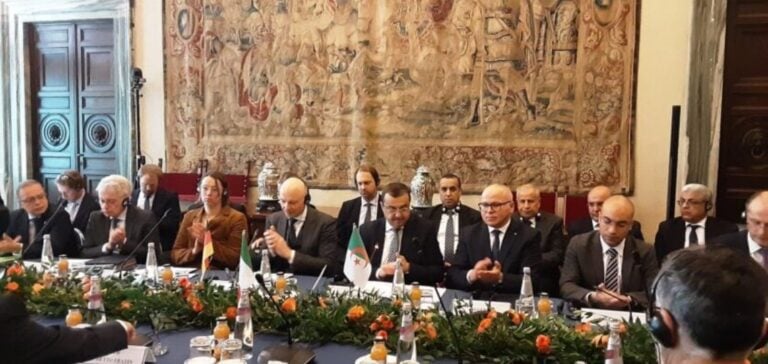The project called SoutH2 Corridor brings together several countries and companies around a single objective: transporting green hydrogen from North Africa to Central Europe. The ministerial meeting held in Rome brought together representatives from Algeria, Tunisia, Italy, Germany, and Austria. During this meeting, discussions focused on the means of building a pipeline of approximately 3,300 kilometers. Participants also addressed Algeria’s potential role in producing green hydrogen, given its solar and wind resources.
An organized energy route
Companies involved in the project, such as Snam and TAG, are working on technical studies to adapt and expand existing infrastructures. Algeria already has gas pipelines connected to the European continent, notably the Trans-Mediterranean Pipeline (Transmed), and these facilities could be partially repurposed. Modernization and construction of new segments are planned to transport hydrogen at a commercially viable flow rate. The Algerian Ministry of Energy specified that feasibility studies will include procedures to ensure the security and efficiency of future cross-border flows.
Political representatives highlighted the need for clear regulatory frameworks to facilitate hydrogen transit across borders. The European Union (EU) supports this effort as part of its energy diversification goals. The European Commission is involved as an observer to monitor progress on the SoutH2 Corridor, classified as a Project of Common Interest (PCI). The countries in question plan to establish a timetable for completing this pipeline by 2030, in line with the REPowerEU Plan (REPowerEU).
Commercial prospects and industrial commitment
Sonatrach and Sonelgaz—Algeria’s public hydrocarbon company and its national electricity and gas company, respectively—have been tasked with determining local production capacities. International investors could collaborate on building desalination facilities to secure the water supply required for electrolysis. Technical missions will assess the opportunity to set up large-scale photovoltaic and wind power plants, given the natural resources available in various Algerian regions.
The signatory governments emphasized the importance of coordinated investment plans. Bilateral financing between the EU and Algeria would include mechanisms aimed at reducing risks inherent to large-scale infrastructure projects. Ongoing talks address establishing guarantees related to regulatory stability and the repayment of loans contracted to develop the equipment. European financial institutions and other partners are already evaluating the macroeconomic impact of this partnership.
Regional coordination and benefits for the Maghreb
Tunisia, a stakeholder in the project, plans to capitalize on existing gas pipeline sections crossing its territory to develop its own green hydrogen production capacity. Specialists are studying the feasibility of expanding transport infrastructure to serve multiple areas. The idea is to optimize existing routes and limit construction costs while making the corridor competitive in international markets.
Authorities in the Maghreb countries point out that this project could stimulate economic activity and job creation. Deploying solar and wind farms requires diverse skills, from designing industrial equipment to managing smart electrical grids. Commercial partnerships could multiply around the provision of services and technologies, provided each participant meets agreed-upon standards of reliability and performance.
Regulatory adaptation and European objectives
The legislative framework defined by the Trans-European Energy Networks (TEN-E) directs how hydrogen transport projects are classified. The consortia in charge of the SoutH2 Corridor must meet traceability and technical compatibility requirements to effectively link North Africa to Europe. The EU has stated that the proportion of green hydrogen in European energy consumption must gradually rise to reduce dependence on imported fossil fuels.
Sector experts estimate that the pipeline’s capacity could reach four million tons of green hydrogen per year. Such a quantity would account for a significant share of Europe’s renewable hydrogen goals. Austrian and German industries wish to secure their supply while diversifying energy sources in order to strengthen their global competitiveness.
Infrastructure and logistical challenges
Operators committed to the project are analyzing the need for compression stations and systems to monitor hydrogen purity. This technical aspect directly affects the corridor’s profitability, as it influences how much energy can flow daily. Maintenance plans call for continuous coordination among the various transport companies to minimize service interruptions. Compliance with international standards on infrastructure safety remains a key concern for all partners.
Negotiations are also underway regarding hydrogen transit pricing, a determining factor for the sustainability of the sector. Current talks aim to set tariffs that account for infrastructure amortization costs and fair distribution of profits. Governments involved in the corridor are proposing the creation of dedicated regulatory bodies authorized to establish transparent rules for cross-border hydrogen trade.
Risk assessment and project monitoring
Stakeholders agree to meet regularly to evaluate progress and achievement of technical objectives. Joint committees include energy production specialists, infrastructure experts, and economists. Studies cover soil stability along the pipeline route as well as ecosystem protection. Algerian authorities indicate that some regions require extensive research to control costs and avoid delays.
Financial oversight encompasses management of funds allocated by international institutions and private partnerships. Lenders require performance indicators, notably for meeting deadlines and quality standards. Maghreb countries are counting on knowledge transfer that could generate knock-on effects for other economic sectors. Various coordinating bodies ensure overall coherence among the different phases of the corridor’s deployment.
Regional perspectives and future interconnections
Energy market observers are exploring how this corridor might influence natural gas trade, which has traditionally dominated exchanges between Algeria and Europe. Diversification plans foresee hydrogen coexisting with other energy sources without necessarily replacing them immediately. Algerian industry views the project as an opportunity to modernize production infrastructure and acquire technological expertise that could be exported elsewhere.
Envisioned scenarios include the possibility of extending the network to additional European countries. Consultations may be initiated with new stakeholders to broaden the SoutH2 Corridor’s scope. The next steps depend on securing investments and ensuring the technical and economic viability of proposed solutions. Ongoing initiatives raise questions about Algeria’s position in the international energy architecture.






















